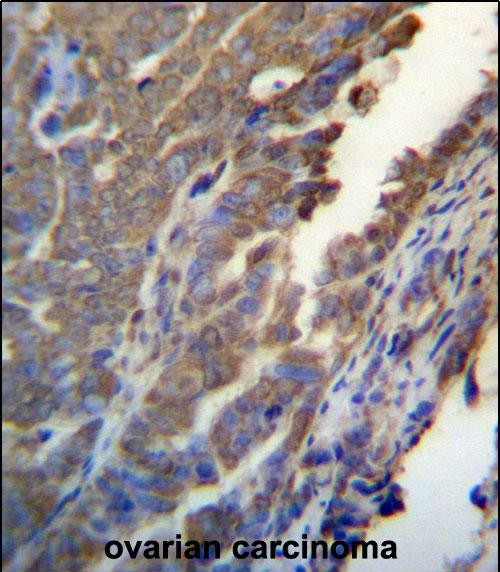ASB4 Antibody (C-term)
Affinity Purified Rabbit Polyclonal Antibody (Pab)
- SPECIFICATION
- CITATIONS
- PROTOCOLS
- BACKGROUND

Application
| IHC-P, WB, E |
|---|---|
| Primary Accession | Q9Y574 |
| Other Accession | NP_057200.1, NP_665879.1 |
| Reactivity | Human |
| Host | Rabbit |
| Clonality | Polyclonal |
| Isotype | Rabbit IgG |
| Calculated MW | 48195 Da |
| Antigen Region | 226-255 aa |
| Gene ID | 51666 |
|---|---|
| Other Names | Ankyrin repeat and SOCS box protein 4, ASB-4, ASB4 |
| Target/Specificity | This ASB4 antibody is generated from rabbits immunized with a KLH conjugated synthetic peptide between 226-255 amino acids from the C-terminal region of human ASB4. |
| Dilution | IHC-P~~1:10~50 WB~~1:1000 E~~Use at an assay dependent concentration. |
| Format | Purified polyclonal antibody supplied in PBS with 0.09% (W/V) sodium azide. This antibody is purified through a protein A column, followed by peptide affinity purification. |
| Storage | Maintain refrigerated at 2-8°C for up to 2 weeks. For long term storage store at -20°C in small aliquots to prevent freeze-thaw cycles. |
| Precautions | ASB4 Antibody (C-term) is for research use only and not for use in diagnostic or therapeutic procedures. |
| Name | ASB4 |
|---|---|
| Function | Probable substrate-recognition component of a SCF-like ECS (Elongin-Cullin-SOCS-box protein) E3 ubiquitin-protein ligase complex which mediates the ubiquitination and subsequent proteasomal degradation of target proteins. Promotes differentiation and maturation of the vascular lineage by an oxygen-dependent mechanism (By similarity). Also acts as a negative regulator of GPS1, a component of the COP9 signalosome (CSN) multiprotein complex, thereby inhibiting the serine phosphorylation of IRS1 (By similarity). Regulates IRS4 levels by directing its degradation via ubiquitination and thereby decreases the downstream signal of IRS4 (PubMed:21955513). Plays a critical role during early vascular development and proper placentation. Mechanistically, negatively regulates the transcriptional regulator inhibitor of DNA binding 2/ID2 expression through polyubiquitination and proteasome dependent degradation (PubMed:24586788). |
| Cellular Location | Cytoplasm {ECO:0000250|UniProtKB:Q9WV71}. |

Thousands of laboratories across the world have published research that depended on the performance of antibodies from Abcepta to advance their research. Check out links to articles that cite our products in major peer-reviewed journals, organized by research category.
info@abcepta.com, and receive a free "I Love Antibodies" mug.
Provided below are standard protocols that you may find useful for product applications.
Background
The protein encoded by this gene is a member of the ankyrin repeat and SOCS box-containing (ASB) family of proteins. They contain ankyrin repeat sequence and SOCS box domain. The SOCS box serves to couple suppressor of cytokine signalling (SOCS) proteins and their binding partners with the elongin B and C complex, possibly targeting them for degradation. Multiple alternatively spliced transcript variants have been described for this gene but some of the full length sequences are not known.
References
Li, J.Y., et al. J. Neuroendocrinol. 17(6):394-404(2005)
Kile, B.T., et al. Trends Biochem. Sci. 27(5):235-241(2002)
Kile, B.T., et al. Gene 258 (1-2), 31-41 (2000) :
If you have used an Abcepta product and would like to share how it has performed, please click on the "Submit Review" button and provide the requested information. Our staff will examine and post your review and contact you if needed.
If you have any additional inquiries please email technical services at tech@abcepta.com.













 Foundational characteristics of cancer include proliferation, angiogenesis, migration, evasion of apoptosis, and cellular immortality. Find key markers for these cellular processes and antibodies to detect them.
Foundational characteristics of cancer include proliferation, angiogenesis, migration, evasion of apoptosis, and cellular immortality. Find key markers for these cellular processes and antibodies to detect them. The SUMOplot™ Analysis Program predicts and scores sumoylation sites in your protein. SUMOylation is a post-translational modification involved in various cellular processes, such as nuclear-cytosolic transport, transcriptional regulation, apoptosis, protein stability, response to stress, and progression through the cell cycle.
The SUMOplot™ Analysis Program predicts and scores sumoylation sites in your protein. SUMOylation is a post-translational modification involved in various cellular processes, such as nuclear-cytosolic transport, transcriptional regulation, apoptosis, protein stability, response to stress, and progression through the cell cycle. The Autophagy Receptor Motif Plotter predicts and scores autophagy receptor binding sites in your protein. Identifying proteins connected to this pathway is critical to understanding the role of autophagy in physiological as well as pathological processes such as development, differentiation, neurodegenerative diseases, stress, infection, and cancer.
The Autophagy Receptor Motif Plotter predicts and scores autophagy receptor binding sites in your protein. Identifying proteins connected to this pathway is critical to understanding the role of autophagy in physiological as well as pathological processes such as development, differentiation, neurodegenerative diseases, stress, infection, and cancer.



